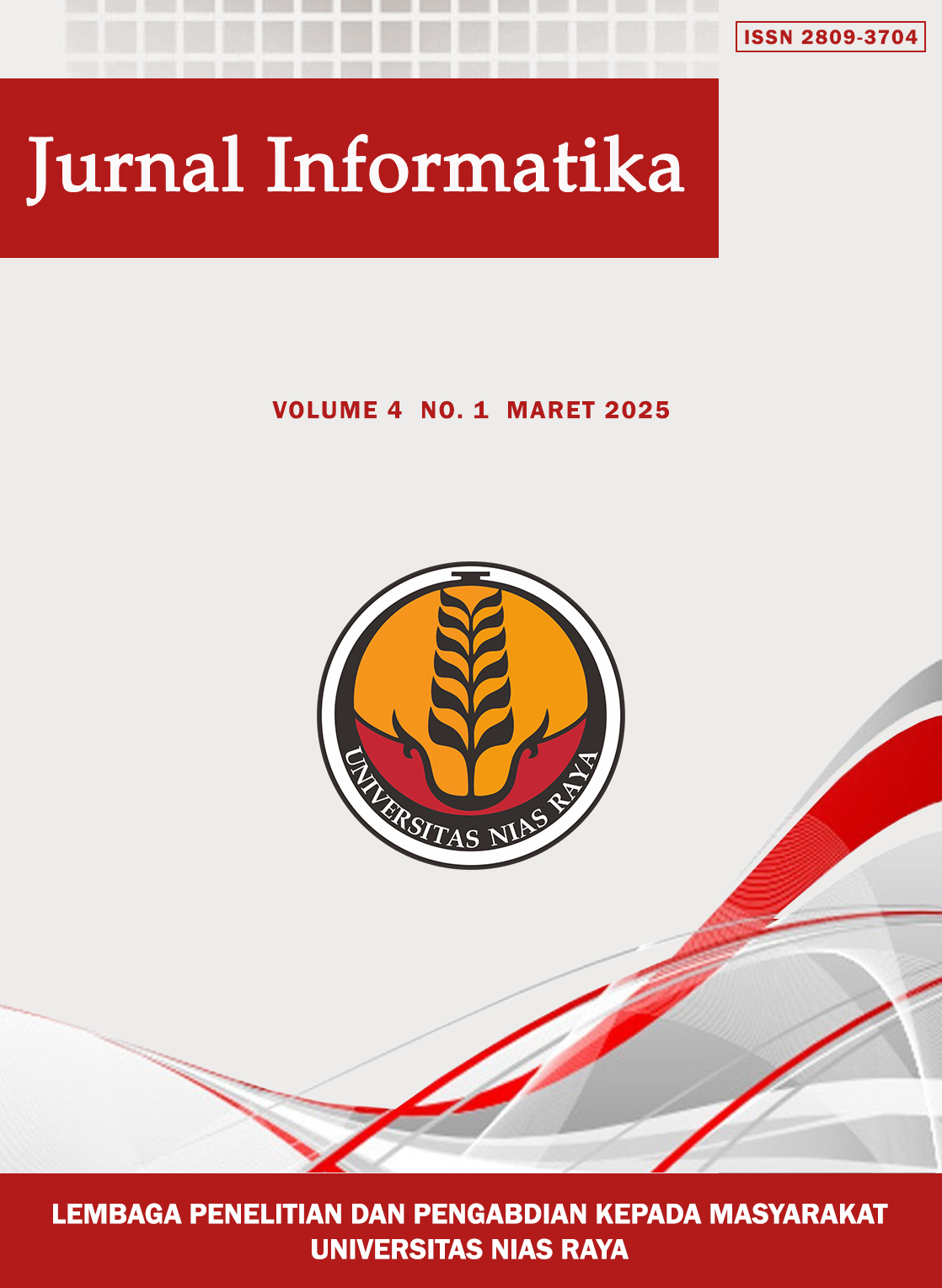Implementasi Algoritma K-Nearest Neighbor Berbasis Website pada Sistem Rekomendasi Persewaan Alat Camping
Abstract
Development of information technology currently provides opportunities for business owners to improve efficiency and quality of service including in the camping equipment rental industry. Aygadventure as one of the camping equipment rental companies faces several operational constraints such as inefficient manual recording, long queues, and errors in data management. This study aims to design and implement a website-based rental recommendation system using the K-Nearest Neighbor (K-NN) algorithm to overcome these problems. The K-NN algorithm is used to provide product recommendations based on rental data to increase efficiency in the transaction process. The system development method uses the Prototyping method which allows system adjustments according to user needs. System testing uses several methods including white box testing, black box testing, and user satisfaction testing with satisfactory results. White box testing shows 100% successful coding results in the system, while black box testing results in full success on all features and functionalities of the system being tested. The results of the user acceptance test show an average satisfaction of 83.30%, respondents expressed satisfaction with the aspects of usability, access speed, and ease of navigation. Thus, this system successfully improves Aygadventure's operational efficiency, provides a better user experience, and increases overall customer satisfaction.
References
E. Syahputra, S. Hutasuhut, and Hasyim, “The Development of the Digital Economy in the Millenial Generation,” in International Seminar on Islamic Studies (INSIS 6), Medan: Universitas Muhammadiyah Sumatera Utara, 2024, pp. 1077–1085.
T. A. Berutu, D. L. R. Sigalingging, G. K. V. Simanjuntak, and F. Siburian, “Pengaruh Teknologi Digital terhadap Perkembangan Bisnis Modern,” Neptunus J. Ilmu Komput. Dan Teknol. Inf., vol. 2, no. 3, pp. 358–370, 2024, doi: 10.61132/neptunus.v2i3.258.
Yolveri and B. Emely, “Strategi Pengembangan Aktivitas Hiking, Camping, Bersampan Di Kawasan Ikan Banyak, Nagari Pandam Gadang, Kabupaten Lima Puluh Kota,” Menara Ilmu, vol. XVI, no. 1, pp. 127–134, 2022.
L. Rahmawati, D. D. Rahayu, H. Nivanty, and W. Lutfiah, “Fintech Syariah : Manfaat Dan Problematika Penerapan Pada UMKM,” J. Masharif al-Syariah J. Ekon. dan Perbank. Syariah, vol. 5, no. 1, pp. 75–90, 2020.
E. Najwaini, T. E. Tarigan, F. P. Putra, and Sulistyowati, “Application of the K-Nearest Neighbors (KNN) Algorithm on the Brain Tumor Dataset,” Int. J. Artif. Intell. Med. Issues, vol. 1, no. 1, pp. 18–26, 2023, doi: 10.56705/ijaimi.v1i1.85.
H. A. D. Fasnuari, H. Yuana, and M. T. Chulkamdi, “Penerapan Algoritma K-Nearest Neighbor untuk Klasifikasi Penyakit Diabetes Melitus,” Antivirus J. Ilm. Tek. Inform., vol. 16, no. 2, pp. 133–142, 2022, doi: 10.35457/antivirus.v16i2.2445.
U. Nijunnihayah, S. S. Hilabi, F. Nurapriani, and E. Novalia, “Implementasi Algoritma K-Nearest Neighbor untuk Prediksi Penjualan Alat Kesehatan pada Media Alkes,” MALCOM Indones. J. Mach. Learn. Comput. Sci., vol. 4, no. 2, pp. 695–701, 2024, doi: 10.57152/malcom.v4i2.1326.
A. Sumiah and N. Mirantika, “Perbandingan Metode K-Nearest Neighbor dan Naive Bayes untuk Rekomendasi Penentuan Mahasiswa Penerima Beasiswa pada Universitas Kuningan,” Buffer Inform., vol. 6, no. 1, pp. 1–10, 2020.
F. Rizal and N. Nadiyah, “Perbandingan Algoritma K-Nearest Neighbor untuk Klasifikasi Jenis Mangga Menggunakan Berdasarkan Fitur Gray Level Co-Occurrence Matric dan Fitur Warna,” COREAI J. Kecerdasan Buatan, Komputasi dan Teknol. Inf., vol. 2, no. 2, pp. 1–10, 2022, doi: 10.33650/coreai.v2i2.3099.
G. D. M. Zulma, Angelika, and N. Chamidah, “Perbandingan Metode Klasifikasi Naive Bayes, Decision Tree dan K-Nearest Neighbor pada Data Log Firewall,” in Seminar Nasional Mahasiswa Ilmu Komputer dan Aplikasinya (SENAMIKA), A. Zaidiah, Ed., Jakarta: Fakultas Ilmu Komputer Universitas Pembangunan Nasional Veteran Jakarta, 2021, pp. 679–688. [Online]. Available: https://conference.upnvj.ac.id/index.php/senamika/article/view/1396
R. S. A. Daulay, “Analisis Kritis dan Pengembangan Algoritma K-Nearest Neighbor (KNN): Sebuah Tinjauan Literatur,” J. Pendidik. Sains dan Komput., vol. 4, no. 2, pp. 131–141, 2024, doi: 10.47709/jpsk.v4i02.5055.
G. E. A. Kustanto and H. P. Chernovita, “Perancangan Sistem Informasi Manajemen Berbasis Web Studi Kasus : PT Unicorn Intertranz,” J. Teknol. Inf. dan Ilmu Komput., vol. 8, no. 4, pp. 719–728, 2021, doi: 10.25126/jtiik.2021844849.
S. A. Asri, I. N. G. A. Astawa, I. G. A. M. Sunaya, K. A. Yasa, I. N. E. Indrayana, and W. Setiawan, “Implementation of Prototyping Method on Smart Village Application,” J. Phys. Conf. Ser., vol. 1569, no. 3, pp. 1–6, 2020, doi: 10.1088/1742-6596/1569/3/032094.
R. S. Pressman and B. R. Maxim, Software Engineering: A Practioner’s Approach, 9th ed. New York: McGraw Hill, 2020.
S. Kamal, Y. Mardi, and R. Sakila, “Perancangan Prototype Sistem Informasi Rawat Jalan pada RSU Aisyah Padang Tahun 2022,” J. Ilm. Perekam dan Inf. Kesehat. Imelda, vol. 8, no. 1, pp. 28–38, 2023, doi: 10.52943/jipiki.v8i1.1179.
Lasminiasih, G. E. Saputra, R. B. Utomo, and E. Wiseno, “Using Prototyping Method for Analysis and Design of Information System for Student Registration in Sekolah Master,” Int. J. Sci. Technol., vol. 1, no. 2, pp. 19–29, 2022, doi: 10.56127/ijst.v1i2.140.
D. J. C. Sihombing, “Exploring Prototype Methodology in Land Information System Development : Design and Evaluation of an Application,” J. Info Sains Inform. dan Sains, vol. 14, no. 01, pp. 594–604, 2024, doi: 10.54209/infosains.v14i01.
S. Narulita, A. Nugroho, and M. Z. Abdillah, “Diagram Unified Modelling Language (UML) untuk Perancangan Sistem Informasi Manajemen Penelitian dan Pengabdian Masyarakat (SIMLITABMAS),” Bridg. J. Publ. Sist. Inf. dan Telekomun., vol. 2, no. 3, pp. 244–256, 2024, doi: 10.62951/bridge.v2i3.174.
S. Setiaji and R. Sastra, “Implementasi Diagram UML (Unified Modelling Language) Pada Perancangan Sistem Informasi Penggajian,” J. Tek. Komput. AMIK BSI, vol. 7, no. 1, pp. 106–111, 2021, doi: 10.31294/jtk.v4i2.
A. Fu’adi and A. Prianggono, “Analisa dan Perancangan Sistem Informasi Akademik Akademi Komunitas Negeri Pacitan Menggunakan Diagram UML dan EER,” J. Ilm. Teknol. Inf. Asia, vol. 16, no. 1, pp. 45–54, 2022, [Online]. Available: https://jurnal.stmikasia.ac.id/index.php/jitika/article/view/650
S. Gao, “Trend-Based K-Nearest Neighbor Algorithm in Stock Price Prediction,” in The 3rd International Conference on Digital Economy and Computer Application (DECA 2023), Shanghai, China: Atlantis Press International BV, 2023, pp. 746–756. doi: 10.2991/978-94-6463-304-7_78.
R. Nuraeni and S. Surono, “Rough Set Theory for Dimension Reduction on Machine Learning Algorithm,” J. Fourier, vol. 10, no. 1, pp. 29–37, 2021, doi: 10.14421/fourier.2021.101.29-37.
M. Danny, A. Muhidin, and A. Jamal, “Application of the K-Nearest Neighbor Machine Learning Algorithm to Preduct Sales of Best-Selling Products,” Brill. Res. Artif. Intell., vol. 4, no. 1, pp. 255–264, 2024, doi: 10.47709/brilliance.v4i1.4063.
I. R. Dhaifullah, M. Muttanifudin H, A. Ananda Salsabila, and M. Ainul Yaqin, “Survei Teknik Pengujian Software,” J. Autom. Comput. Inf. Syst., vol. 2, no. 1, pp. 31–38, 2022, doi: 10.47134/jacis.v2i1.42.
M. F. Aulia and A. Avorizano, “Penerapan Teknologi Single Page Application (SPA) pada Sistem Surat Disposisi Online (Sudion) di Universitas Muhammadiyah Prof Dr Hamka,” J. Tek. Inform. dan Komput., vol. 1, no. 1, pp. 19–24, 2022, doi: 10.22236/jutikom.v1i1.8740.
A. Maspupah, A. Rahmani, J. L. Min, and T. A. Roshinta, “Software Testing in the Indonesian Industry: Survey of Methods, Tools, and Documentation,” Innov. Res. Informatics, vol. 6, no. 2, pp. 106–117, 2024.
I. Afrianto, A. Heryandi, A. Finadhita, and S. Atin, “User Acceptance Test For Digital Signature Application In Academic Domain To Support The Covid-19 Work From Home Program,” Int. J. Inf. Syst. Technol. Akreditasi, vol. 5, no. 3, pp. 270–280, 2021, [Online]. Available: https://tt-el.my.id/.
Copyright (c) 2025 Yusril Ahda Wicaksono, Febrian Wahyu Christanto, Iman Saufik Suasana

This work is licensed under a Creative Commons Attribution 4.0 International License.












